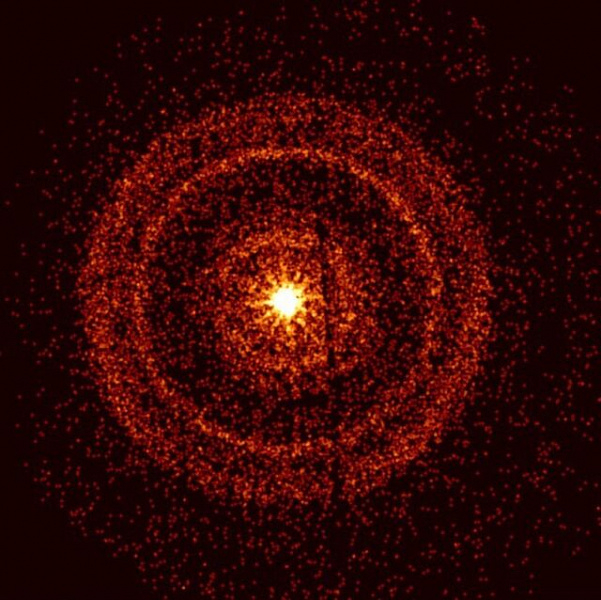Astronomers are searching for an explanation for BOAT's brightness and the absence of heavy elements that contribute to the formation of the Universe
In October 2022, several space detectors detected an exceptionally bright gamma-ray burst, which astronomers called BOAT (Brightest Of All Time — the brightest of all time). In a new paper published in the journal Nature Astronomy, researchers confirmed that this gamma-ray burst was caused by a supernova. However, they did not detect the presence of heavy elements such as platinum and gold, which are usually observed in supernova explosions. This is related to the long-standing question about the origin of these elements.
Gamma-ray bursts — These are flashes of extremely high energy, lasting from a few milliseconds to several hours. There are two classes of gamma-ray bursts. Long bursts, lasting more than two seconds, account for about 70% of all gamma-ray bursts. They are often accompanied by a bright afterglow and are usually associated with galaxies undergoing active star formation. Astronomers believe these flares result from the collapse of massive stars that become neutron stars or black holes.
Short gamma-ray bursts, lasting less than two seconds, account for about 30% of all gamma-ray bursts. They usually come from regions with little star formation. Astronomers believe that such bursts arise from the merger of two neutron stars or the merger of a neutron star with a black hole, forming a so-called kilonova. In 2017, the kilonova hypothesis was confirmed when the Laser Interferometers for Gravitational Waves (LIGO) detected a signal from the merger of two neutron stars, accompanied by a powerful gamma-ray burst.
The gamma-ray burst that occurred in October 2022 (GRB 221009A) belongs to the class of long-lasting bursts and lasted more than 300 seconds. It was recorded by detectors of the Fermi Gamma-ray Space Telescope, the Swift Observatory and the Wind spacecraft, among others, as astronomers gathered for their annual meeting in Johannesburg, South Africa. The source of gamma radiation was the constellation Sagittarius, the signal reached Earth approximately 1.9 billion years later.
Several papers were published last year presenting analytical results from observations of GRB 221009A. Analyzes confirmed that this gamma-ray burst was indeed bright due to the fact that the radiation was directed directly at Earth. However, various studies have also produced several unexpected results that have puzzled astronomers. In particular, the supernova's emission would have been expected to become less intense a few weeks after the initial outburst, but astronomers did not detect this, perhaps because its light was obscured by thick dust clouds.
Peter Blanchard, a professor at Northwestern University, and his colleagues decided to conduct their analysis six months after the observations began to rely on data collected by the James Webb Space Telescope's infrared spectrograph. (JWST) at a later stage of the gamma-ray burst. They also used data from ALMA in Chile to separate the supernova light from the gamma-ray burst afterglow. A particularly important discovery was the discovery of signatures of key elements such as calcium and oxygen that are commonly observed in supernova explosions.
However, the supernova associated with the BOAT gamma-ray burst was not brighter than other supernovae associated with less energetic gamma-ray bursts, which raised eyebrows. Peter Blanchard, a professor at Northwestern University, said: «The same collapsing star that produced a very energetic and luminous gamma-ray burst would also be expected to produce a very energetic and luminous supernova. However, this does not coincide with observations. We have this extremely bright gamma-ray burst, but it's just a normal supernova. The authors suggest that this may be due to the shape and structure of the jet, which was significantly larger than other gamma-ray bursts. Which resulted in a more focused and brighter beam of light.
The analysis of the data also led to a new surprise for astronomers. The only confirmed source of heavy elements in the Universe at the moment is the merger of binary neutron stars. However, according to Peter Blanchard, there are too few neutron star mergers to explain the abundance of heavy elements. This implies that there must be another source for these elements. One hypothetical source is a rapidly rotating massive star that collapses and produces a supernova. But the JWST spectral data obtained for the BOAT gamma-ray burst showed no evidence of the presence of heavy elements.
Peter Blanchard added: «When we were convinced that a gamma-ray burst was associated with the collapse of a massive star, it gave us the opportunity to test a hypothesis about the origin of some of the heaviest elements in the Universe. However, we found no traces of these elements, implying that extremely energetic gamma-ray bursts such as this BOAT do not produce these elements. This doesn't mean that all gamma-ray bursts don't produce heavy elements, but it does expand the variety of processes that produce them. Future observations using JWST will determine whether "common" Gamma-ray bursts associated with BOAT, heavy elements».

